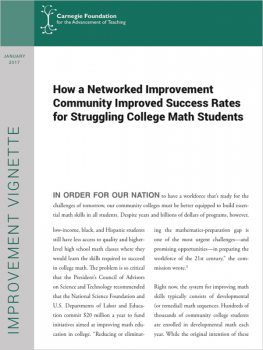How a Networked Improvement Community Improved Success Rates for Struggling College Math Students
The Carnegie Foundation launched its Math Pathways initiative nearly six years ago at 29 colleges across the country with the aim of improving success rates in developmental math. Tens of thousands of students a year, who need additional preparation for college-level math, are shut out of earning degrees and fulfilling careers due to the huge failure rate in these classes. This narrative describes how Carnegie created the highly successful Pathway program by gathering math and design experts into a networked improvement community (NIC) that applied the principles of improvement science in its work.
Improvement science is an evidence-based process of problem solving guided by a set of principles that includes identifying a specific problem, designing a solution that focuses on the needs of the users (such as students), and continually measuring and refining results to make sure they’re working. For its user-centered approach, NIC members listened to students and identified both external and self-imposed barriers to success in traditional developmental math. They then addressed these specific challenges with their program design. Improvement science also required the Pathways NIC to understand the local contexts within each school and at schools across the country in order to design an intervention that colleges could adapt so that they would work for different subgroups of students, under varied constraints and circumstances. The result of this work are two accelerated developmental math programs — Statway® and Quantway®.
Combined, Statway and Quantway have served more than 20,000 students since the 2011-2012 academic year with triple and double the success rates, respectively, in half the time as traditional developmental math, including when it comes to earning college-level math. As the initiatives were being implemented and expanded, Carnegie, as the organizing hub for the NIC, took on the task of identifying emerging problems and forming improvement teams to work on them. Results and new adaptations continue to be measured today in an effort to improve future results even more.





